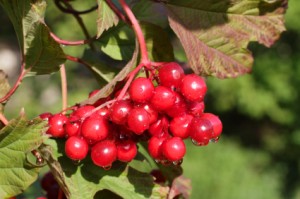Viburnum-opulus
Viburnum opulus is more commonly known as the guelder rose. It also has some other common names, including European cranberry bush, red elder and gatten.
Description
Viburnum opulus is a deciduous shrub which stands erect. It can grow up to five metres and displays three lobed, palmed leaves which resemble maple leaves. In the spring and summer, small white-green flowers bloom as well as larger white ones. The green leaves turn red in autumn and then the plant produces bright red berries.
Habitat
The natural habitat of the Viburnum opulus is Europe and Asia, although one of the most popular varieties, the snowball tree, comes from Holland. The shrub enjoys outdoor living in well-drained and moist soil. It is a very hardy plant which is happy in full or partial sun or even shade.
Availability
It is available usually in the winter months. Propagation can be achieved through seeds and soft-wood or semi-hardwood cuttings.
Species
Opulus is the species, Vibernum is the genus. Vibernum belongs to the honeysuckle family, known as Caprifolicaeae. There are two varieties of opulus shrub – fertile and infertile. The geulder rose is the fertile variety, while one of the most popular varieties – the snowball tree, named for its white-headed blossom – is the Vibernum opulus’ sterile variety.
Care Tips
Viburnum opulus flowers need to be kept in water if indoors. The stems should be cut diagonally with a sharp knife. It’s best to remove the leaves first and to also keep the stems in plenty of water before arranging in order to condition them. Although the berries appear highly attractive and are sometimes used to make jams, they can cause an upset stomach if eaten in large numbers.
Did You Know?
Another common name for this plant is ‘cramp bark’. Viburnum opulus is the most potent uterine antispasmodic of the various Viburnum species because it contains more of the antispasmodic constituent, scopoletin.
The medicinal part is the bark, which is collected from the shrub in early spring, April or May, chopped into bits, dried, and stored in readiness for muscle cramps and strain. Cramp bark has even been used to halt contractions during premature labour, and in the last trimester of pregnancy to build up uterine muscles and ensure an easy labour.
References
http://www.bbc.co.uk/gardening/plants/plant_finder/plant_pages/11175.shtml
http://apps.rhs.org.uk/plantselector/plant?plantid=2007
http://www.planetbotanic.ca/fact_sheets/cramp_bark.htm



